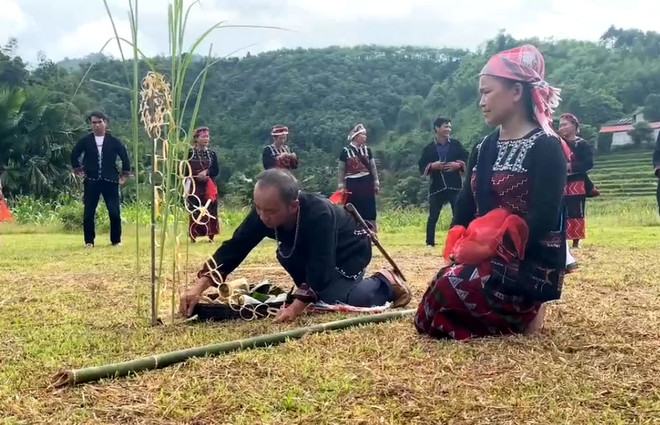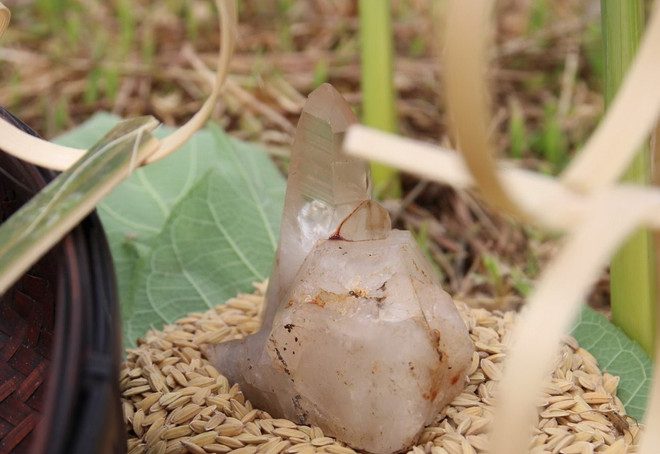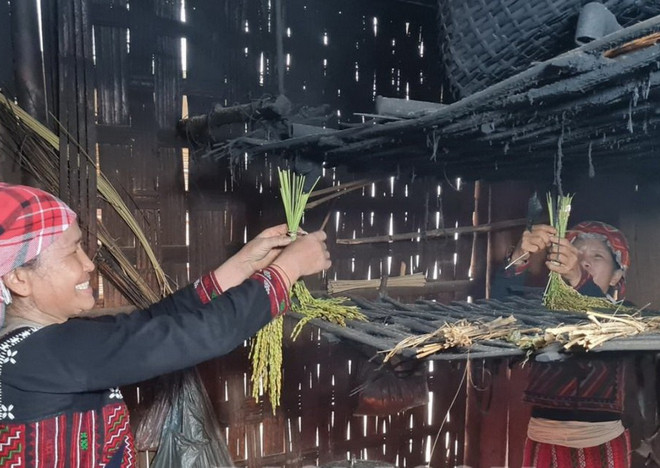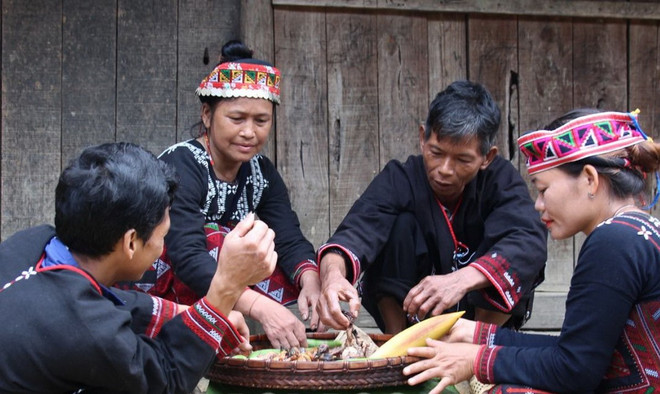If you come to Lao Cai during the golden autumn, from August to October of the lunar calendar, visitors may be lucky enough to witness the New Rice Festival of the Xa Pho people - a sacred and humane ceremony, expressing gratitude to heaven and earth, ancestors and wishing for a bountiful harvest.
The Xa Pho people, belonging to the Phu La ethnic group, live concentrated in Sa Pa, Van Ban and Lao Cai city. Over many generations, they have cultivated unique traditional cultural values. Among them, the New Rice Festival is a sacred ritual, closing a farming season, offering thanks to heaven and earth and expressing gratitude to ancestors.
Over the past 300 years, this ritual has been preserved intact, becoming an indispensable part of the community's cultural life, and was recently listed in the National Intangible Cultural Heritage List by the Ministry of Culture, Sports and Tourism.
Sacred time in the farming cycle
The New Rice Festival is the final activity of the chain of slash-and-burn labor: when the rice begins to bear fruit, when the fields turn a rich yellow, families in the village choose a good day and a good time to celebrate the New Year.
This is also an occasion to summarize a year of production, a time to offer the newest rice flowers and grains to the gods and ancestors; at the same time, pray for favorable weather, bountiful crops, and healthy children.

The New Rice Festival usually takes place around the tenth lunar month but can also take place earlier. In their beliefs, the Xa Pho people avoid celebrating the New Rice Festival in odd months, so if the harvest is favorable and the rice ripens early, the New Rice Festival can begin in the eighth lunar month.
The magic stone and the secret to keeping the soul of mother rice
The most unique thing about the New Rice Festival ritual is "keeping the spirit of mother rice" in the fields and "bringing the spirit of mother rice" home.
On the first day of the New Rice Festival, the couple gets up early to harvest rice with many rituals and taboos. They bring with them rice packets, a sickle, a basket over their heads, and most importantly, a magic stone – a white stone with many pentagonal grains that look like rice grains – considered to contain the spirit of rice.

The first day of harvest is like welcoming the rice spirit home, so everything must be taboo: the homeowner goes straight to the field, no turning or shortcuts are allowed. On the way, do not ask or answer other people, because it is believed that any careless words can upset the rice spirit and cause the appointment to be missed.
When approaching the field, the landlady built a fence to prevent anyone from passing through and disturbing the spirit of the rice. She plucked three wormwood leaves to wrap the magic stone, then walked into the middle of the field, facing the rising sun, held her breath, gathered three rice stalks, and used the rice leaves to tie them into a large bush. She put the "magic stone" in the middle of the rice bush to make the spirit of the mother rice "Xè ma." When the tie was finished, the landlady could breathe easily.
After keeping the rice spirit, she went down to the foot of the field to pick three ears of rice and then pulled up three stubbles to keep the rice spirit at the foot of the field. After this ritual, she and her new husband started going from the foot of the field to the top of the field to pick each ear of rice.
On the second day, the landlady and her relatives came to exchange labor for helping to harvest the rice. According to the Xa Pho people's belief, when harvesting rice, everyone must absolutely not blink, because if they blink while picking and tying the bundle, the rice grains will fall. When harvesting, they must also not breathe heavily because breathing heavily will scare the rice spirit and cause it to leave the field. These taboos make the rice harvesting work have a slow, respectful rhythm.
When preparing to harvest the rice, the landlady went to the place where the rice soul was kept, took the incubated rice, brought it to the foot of the field and shouted loudly: "Everyone, please harvest the rice, I am here to keep the rice soul."
Hearing the shout, everyone started carrying each bundle of rice to the gathering place at the foot of the field. The landlady took three ears of rice and stuffed them into the bundle of the best rice to use as seeds for the following year, while everyone continued to pick rice until the field was finished.
Next, the landowner went to welcome the spirit of the mother rice. At this time, she held her breath again, removed the string to take out the magic stone and put it in her bag. After that, the landowner counted the number of rice clusters, stacking every three clusters into a pile. If the last number of clusters was odd, it meant that the following year the rice crop would be a good harvest.
Bringing rice home - a family ritual
Then everyone carried the rice back home. Xa Pho women used a sling to carry it over their heads, while the men used a pole to swing the two bundles of rice on their shoulders back home.
In the past, the Xa Pho people often built rice warehouses next to the forest, near their houses for convenience and to avoid fire, but today most of them store rice on the attic floor inside their houses.

When bringing rice into the house, the homeowner closes all the doors to avoid scaring the spirit of mother rice and causing it to leave. The homeowner places the rice on a tray and divides it into portions: 1 handful of regular rice, 1 handful of sticky rice to offer; the rest is placed on the kitchen shelf to dry.
People stacked 3 bunches of rice on top of each other, creating a “rice flower,” then the homeowner placed the spirit of the mother rice in the middle of the pile of rice and said: “Mother rice spirit, please stay in the house.”
New meal and lucky customs
The ritual of drying, blanching and pounding rice to steam “new rice” is also very skillful: the homeowner only needs to take a little bit of new rice, blanch it in boiling water, then dry it on the kitchen loft, then knead it into rice and steam it with the old rice - thus having new rice to eat for Tet.
On the day of the New Year's Eve ceremony, the hostess woke up at 3am to put rice in the steamer, and prepared offerings including 3 ginger flowers, 3 bunches of Solanum procumbens, 1 package of squirrel meat, 3 mung beans, 3 squashes, and 1 red banana flower.
When the rice is cooked, everything is poured onto a tray lined with banana leaves; on top are pork, chicken, bowls, chopsticks, wine, and a bowl of taro soup. The owner places the offering tray in front of the altar, inviting the ancestors to eat the new rice, praying for the ancestors to bless the rice spirit with a good harvest next year, heavy rice grains, and to bless the family with prosperity and happiness.
After the offering, the homeowner invites guests to dinner, and prepares wild banana flowers with yellow skin that look like rice grains, sliced and cooked with ginger; boiled stream goby; dried rat meat; boiled green squash, young reed cores...

In particular, all the banana leaves that line the new rice trays will be put away in a corner of the house by the homeowner, and will be cleaned after 3 days. According to the Xa Pho people's belief, this way the spirit of the new rice and fortune will stay in the house.
To keep the rice spirit in the house, even the landlady must change her clothes every 3 days, so that the rice spirit can recognize its old owner and not leave.
The New Rice Festival ends with dances, the sound of trumpets and flutes resounding throughout the village. Everyone congratulates, sings, and wishes for a new year of bountiful harvests, prosperity for every family, and happiness for everyone.
Not only an agricultural ritual, the New Rice Festival is also a bond that connects the community, where faith and respect for ancestors and nature are nurtured through each generation of the Xa Pho people. By preserving this ritual, the Xa Pho people have preserved a unique traditional cultural feature, reminding of the strong relationship between people, fields and weather - a lesson in respecting nature that is very valuable in modern life./.
Source: https://www.vietnamplus.vn/giu-hon-lua-me-nghi-le-tet-com-moi-thieng-lieng-cua-nguoi-xa-pho-o-lao-cai-post1062843.vnp


![[Photo] Prime Minister Pham Minh Chinh attends the groundbreaking ceremony of two key projects in Hai Phong city](https://vphoto.vietnam.vn/thumb/1200x675/vietnam/resource/IMAGE/2025/9/27/6adba56d5d94403093a074ac6496ec9d)







































































































Comment (0)